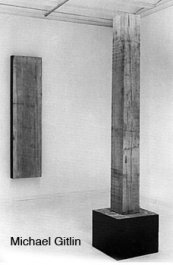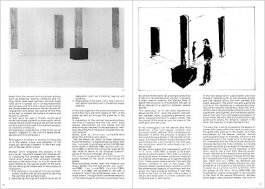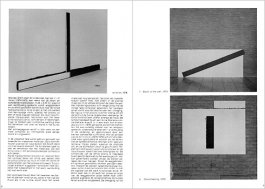International Cultureel Centrum 1980
Equilibrium
by Annie Gentils
Rational analytic research of what lies behind appearance, not accepting imposed concepts and norms, searching for fundamental structures and connections, and the investigation of the nature of perception, greatly mark the attitude of mind that determined the art of the last two decades. Minimalism (Structuralism) especially tried as rationally as possible to get close to reality: subjectivity and accidental elements, illusion or representation of a part of reality were avoided. The artists arrived at a strictly geometric-abstract style, characterized by a logical exactness, order, perfection in the finishing touches, wherein every autobiographical or personal element was missing, because it was experienced as being unpredictable and subjective.
The material and its elementary forms became the basic determiners: reality was experienced as content, through the material itself, the artists exposed the structural contents. The investigation of the relation art-object-space, and connected with this, how this interaction was being experienced by the spectator, was a task of the Minimalist movement. «Die Minimal-Objekte verstehen sich daher weniger als Skulp-turen denn als Sehbarrieren, durch die die Auf-merksamkeit des Betrachters auf Raumfunktio-nale, d.h. zugleich architektonische Aspekte aufgerichtet wird.» (1)
Such a strict artstyle with a negation of the personal aspects cannot exist without being reacted upon: the Minimalist movement laid the basis and gave occasion for the several other art tendencies of the past decade. This amalgam of art branches Robert Pincus-Witten calls Post minimalism, in analogy with the evolution from Impressionism (2) to Post impressionism. The essential attainments of Minimalism remained: the analytic investigation of reality in all fields, the use of the material, the structure of the material itself as art-object and as signifiant, and the investigation of the relation art-object–space-spectator. But what are being re-introduced in the work of art are the personal, individual and autobiographical elements, visually expressed in man-made marks on the material. In a pictorial, often expressionistic way, the complete act of creation is being suggested. This can also be seen in the choice of the material. Nevertheless this new personal and pictorial style along with the integration of the act of creation in the piece of art, can be regarded as a prolonging and further elaboration of the anxiety of Minimalism for a correct transfer of knowledge to the spectator: “...The virtual content of the art became that of the spectator’s intellectual recreations of the action used by the artist to realize the work in the first place.” (3)
All these elements allow the unpredictable accident into a work of art, what was scrupulously avoided in the clearly structured and preconceived works of the Minimalists. R. Pincus-Witten makes a global distinction in Post minimalism between Conceptual Art, which functions primarily on a linguistic basis, and the more material-oriented Abstract expressionistic art tendencies, which transfer mental structures, based on an analytic logic, in a nonverbal way onto the spectator. The author speaks of “an abstract information-based epistemology.” (4)
Michael Gitlin’s work could be situated in this last group. His work can be seen as a synthesis of the attainments of Minimalism and Post minimalism:
– a direct approach to reality through the use of a particular material with its specific structures and form as art object, and a direct signifiant.
– a conceived, planned separation and restructuring of the material that determines the form.
– the investigation of the relation between art object and context: field or space, and, in this connection the investigation of the second and third dimension.
– the investigation of the relation art object and spectator, which is also being expressed in the sizes of the works, that approximate man’s height and man’s size.
Gitlin’s work is almost a critique on Minimalism in the way it raises problems, resolved in his pieces, in which subjective, personal and accidental touches are evident. These are further emphasized through the use of materials: wood and plywood, the painterly and manual treatment of these materials and the fact that he incorporates the dimensions of a manufactured product into the art object.
Michael Gitlin uses wooden planks and beams, plywood sheets and laths, materials with specific characteristics that codetermine, in an unpredictable way, the final result. The artist determines beforehand how he will separate and readjust the material, but deviations cannot be avoided and are accented by such typical treatment of the wood as chopping, sawing, breaking.
In a work such as “Above the Half” (1976) it becomes very clear how much the result may differ from the concept: Gitlin marked the dividing line with a pencil, in this case halfway, before he started to chop the wood with an axe. The result lies remarkably “above the half” (as the artist told me). This difference is made clear once more by chopping the upper half in the same way, in half, and by folding the halves on both sides of the central panel downwards according to their axis.
The lines of fracture of the three panels are adjusted in such a way that the upper lines are on the same height, while the lower lines of the side panels are on unequal height from the floor, next to the standing central panel. The whole plywood sheet was painted black before starting with the axing, so the contrast between the color of the plywood with the paint and the lines of fracture shows once again that it is impossible to reach a rectilinear and finished result using such methods. Besides, wood and plywood have an additional meaning, borrowed from their former organic existence, which would only confuse a Minimalist logic.
Apart from the manual and sculptural actions such as breaking, sawing, chopping and folding, Gitlin also uses painterly actions: black latex paint is spread out in an expressionistic gestual way, and this with a large brush and on the format-material-situation before the artist’s intervention with tools; the outline on the floor or the wall is marked, the surface of planks and beams is covered.
In later work he uses a thicker acrylic paint mixed with black pigment or a wax paint, which makes the act of painting and the activity on the painted wood more clear. Pictorial and sculptural elements intertwine.
No exactness, no perfection in the finish, but an analytic research of the notions space-plane, and second and third dimension.
The research of terrain or territory on the plane or in the space, visual and palpable, or not visual but spiritually present, is the main subject of Michael Gitlin’s work.
Michael Gitlin integrates the process in his work as an important operational mechanism. In visualising this process the spectator can check which spacial field, although invisible, belongs to the work of art, so he can check the area covered by the spacial power of the work. We can distinguish three steps in the process of realisation:
1. The material in its original form and context, mostly marked and accentuated by painting the outlines and surface black.
2. Disordering the original situation by an act of separation such as chopping, sawing and breaking.
3. Regrouping of the parts into a new totality in rest, where symmetry and 1:2 relations create stability.
In the rearrangement the plates and beams turn round their axis and form edges of 180°, in the plane as well as through the plane in the space.
In opposition to the painted demarcation lines, the lines of fraction and the final form, these spacial descriptions are not visible, but are almost visually evoked for the spectator by mentally returning from the action towards the original situation.
Works such as “Demarcation Works” (1976-1977) show this principle very clearly. That the plane too, which is often marked as two-dimensional, is experienced as being relative. This is proved in sculptural works that Michael Gitlin made in 1979 and 1980, such as “White Obstacle” (1980) in which the component against the wall must return to its “original” position, and swing on its axis “through” the wall. The space is experiented as crisscrossing the plane instead of the plane crisscrossing the space.
Most sculptural works, even the massive and heavy works from the last period, e.g. “Suspended” (1980), “Your Move” (1980), “Equilibrium” (1980), and “One for A.S.” (1980), are adjusted to the wall, a context in which two dimensional work is normally shown. Through Gitlin’s work the relativity of this stereotype is underscored: paintings hang, sculptural works stand. By placing a sculpture so to say in a two-dimensional context, it requires a larger spacial working: the statues float in space, the sculpture is in movement, the wall is being reduced to a partition between several spaces.
This particulary so in “Equilibrium” shown at the I.C.C.. Here the relation and tension between static, supporting elements, and labile, hanging elements is clearly visible. The five pieces of the work occupy the space of the room and form one unity.
In his investigation of the second and third dimension (plane and space) or pictorial and sculptural praxis, Michael Gitlin undergoes an evolution in which the process is always the main constituting element in the transfer of concepts. A constant element is also the size of the works being a man’s size, except in the later spacial sculptures, when he uses beams up to 3 meters high.
Michael Gitlin starts this investigation with his “4’ x 8’ Series” (1975-1976), a series of 25 black-painted plywood sheets (1.22 x 2.44 m.), where a rectangular piece is broken out and replaced in a manner which allows us to see the original form. These works have a simple form and the process consists of one or two steps. The plywood sheets painted black remind us of the two-dimensional aspects of paintings and drawings, but have a spacial working in that they relate to the floor or the wall. This process is shown and elaborated in a more complex and intriguing way in later works.
In the next phase Gitlin uses heavier and more massive material such as pine-wooden planks and raw beams which are then painted with black latexpaint. The artist now also paints the outline of the material as a “demarcation line” around the original context line. After this intervention the lines and planes of fraction are more expressive, and together with the demarcation lines on wall and floor, stimulate a recreation of the process. Besides, this pictorial element suggests quite clearly the temporal aspect in the work: the marking of what has been done.
The area covered by the beams or planks that swing round their axis, as well as on the plane (the wall) as in the space, is further emphasized by the heavier material: factors such as gravity start to intervene, not only in the praxis but also in the imagination of the spectator. Compared with the former phase, the action process has become more complex, so tracing its paths becomes a challenge for the spectator. Nevertheless the logic for the spectator is very strict, and to use a term from physics “unanimous”: Michael Gitlin attains a very strong simplicity. The act of separation has an almost Eastern concentration and power. In a work concisely titled “Split Axis” (1976) the elements are brought to a complete stabile end and rest, supported by a 1:2 relation in the division, and stimulated by an almost sacred symmetry. With the phase of the “White Works” (1978-1979) the investigation seems once again to be situated in the field of the second dimension. Michael Gitlin again uses plywood sheets, the front of which are painted white, the back painted black. When referring to these works Gitlin raises the issue of trust between the artist and the viewer. There is indeed evidence in the “White Works” that the back of each sheet is painted black but there is no way to verify this assumption since the works are hung to the wall. Although the works are two-dimensional, they touch upon three-dimensional issues because the back of each work becomes functional.
Michael Gitlin uses the process principle also in this work: the plate that is broken out is folded to the front. The shift from one phase to another re-relates the space with the work. “Spoonfeeding” (1978) and “A Simple Line” (1978) show that, as in the former phase, the elements are brought to a stabile end and rest, while the anticipating phases are clearly present.
By the end of 1979 Michael Gitlin returns, after a short period during which he made smaller sculptural work, to the use of heavier material: small but massive blocks of wood are spread with an emulsion of acrylic and black pigment which gives them a matte black colour in which the brushstrokes remain visible. With the sawed pieces Gitlin makes assemblages with a fine aesthetic working, and this due to their subtle composition. The division of the plane is even more emphasised by the opposition between the blank wood and the black paint. The small size, the use of massive planks and blocks of wood, and the black paint are elements Gitlin keeps in his further evolution. He returns to the process principle, but brings in elements which disrupt its logic: e.g. in “White Obstacle” in which the wall must be “conquered” as an obstacle. In “One for A.S.” the end is again disturbed by suggesting the next step in the process.
In his latest creations the works occupy more space: heavy, massive beams of African wood are dismantled and divided. By breaking apart several pieces, and by placing them opposite each other as in “Equilibrium” (1980) the complete space of the exhibition room is fitted, whereas in former works the spacial working was limited to the field covered by the axis between floor and wall.
The process -principle is still at work, but in a simplified way; in combination with the use of more heavy material, the territorial or spacial working is now almost palpable: the spectator experiences the parts and the totality, simultaneously. The dismantled center of the tree stands as a fixed point in the centre of the room. The removed beams seem to be projected on the opposing walls. Their hanging position gives the composition a labile characteristic: the beams seem to be floating and can in the mind evolve in two directions either to their original centre or through the wall. The contrast with the static position of the central beams suggests that the space is kept under control between these five elements. Only the black base of the central column is evident, the black and visible sides of the hanging beams remind us of the primary phase. Although reuniting the components is impossible, the beams remain, in an almost organic way, unified with each other.
In “Equilibrium” we experience in an electrifying way the space in which the art object is cosmically present. In his work Michael Gitlin shows how the second- and third-dimension fade into each other, by using pictorial and sculptural elements in intertwining contexts which makes them lose their stereotypical meanings.
In his work until 1979 Gitlin shows the presence of space, through the use of a strictly logical process. Now he makes the space palpable and he places the spectator in a radiating space. He no longer uses a complex logical process, but simplifies it.
The constant 1:2 relations and the symmetry in Gitlin’s work show that his oeuvre fits in the dualistic and Bible-oriented Western tradition. In particular “Equilibrium” (1980) gains a sacred field of reference, and reminds us of a holy taboo-place.
English translation: Rudi Horemans.
Notes:
(1) Karin THOMAS. Bis Heute: Stilgeschichte der bildende Kunst im 20. Jahrhundert, (Verlag M. Dumont Schauberg: Koln) 1975, p. 247.
(2) Robert PINCUS-WITTEN. Postminimalism, (Out of London Press: New York, Naristown, Milano) 1977, p. 14–15.
(3) Idem, p. 16.
(4) Idem, p. 18.


